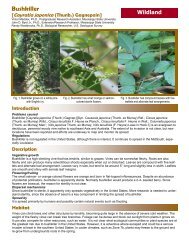RATopic1_95 - Geosystems Research Institute - Mississippi State ...
RATopic1_95 - Geosystems Research Institute - Mississippi State ...
RATopic1_95 - Geosystems Research Institute - Mississippi State ...
You also want an ePaper? Increase the reach of your titles
YUMPU automatically turns print PDFs into web optimized ePapers that Google loves.
Herbicide Efficacy and Monitoring: Herbicide residues in the water column indicate that sufficient concentrations of<br />
penoxsulam were maintained in the pond for at least 30 days (Table 1).<br />
Herbicide injury was noted on plants as early as 1 WAT by severe<br />
chlorosis and reddening of the outer leaves of water lettuce<br />
(Photo 2). At 2 WAT the outer leaves began to deteriorate and<br />
chlorosis was observed in the center of plant rosettes (Photo 3).<br />
By 6 WAT plants were mostly chlorotic and areas of necrotic<br />
(brown) and dead plants were beginning to form (Photo 4). Severe<br />
rosette injury was observed at 7 WAT where the apical portions<br />
of the rosette necrotic and beginning to deteriorate (Photo<br />
5). During this assessment period it was noted that small openings<br />
in the plant mat were beginning to form. At 8 WAT plants<br />
were severely chlorotic/necrotic with large holes beginning to<br />
form in the plant mat (Photo 6). By 9 WAT plants were completely<br />
necrotic, deteriorating, and sinking in the water column<br />
(Photo 7). A follow up assessment 1 year after treatment found<br />
Powe Pond to be completely free of water lettuce (Photo 8).<br />
Photo 4. Powe Pond 6 WAT where plants are showing<br />
severe chlorosis and areas of dead (brown) plants.<br />
signs. Herbicide<br />
applications made in the fall, September and October, were also aided by<br />
frost in late November that killed any remaining plants.<br />
Water lettuce in the outflow creek was also treated on September 22,<br />
2008 along a 1 mile segment. This treatment consisted of spot spraying<br />
individual plants or small collections of plants within the creek or along<br />
the creek bank. The creek was further surveyed during this time as it<br />
Photo 6. Powe Pond at 8 WAT where the<br />
water lettuce mat is breaking up.<br />
Photo 7. Necrotic water lettuce at 9 WAT.<br />
Water lettuce was sensitive to the concentration of penoxsulam<br />
maintained in the water column as indicated by the early injury<br />
emptied into a larger creek<br />
that traversed the R.R. Foil<br />
Plant <strong>Research</strong> Center, at<br />
<strong>Mississippi</strong> <strong>State</strong> University;<br />
however no more<br />
plants were observed and<br />
therefore the spread of water lettuce was stopped in the outflow creek. The<br />
outflow creek was surveyed again approximately 4 WAT (October 2008),<br />
and the water lettuce was necrotic or dead during at this time. Additional<br />
surveys conducted in May September 2009 found no remaining water lettuce<br />
in the outflow creek. Additionally there have been no reports of water<br />
lettuce in the Tennessee Tombigbee Waterway downstream of the Powe<br />
Pond infestation.<br />
By employing<br />
an Early Detection<br />
Rapid Response<br />
protocol<br />
the water lettuce<br />
infestation<br />
was identified,<br />
and ultimately<br />
eradicated before<br />
it could<br />
spread further.<br />
Photo 5. Water lettuce 7 WAT with penoxsulam,<br />
the center of the rosettes beginning to<br />
show signs of necrosis.<br />
Photo 8. Powe Pond approximately 1 year after treatment<br />
with the herbicide penoxsulam.<br />
2009 USGS Annual Report 17 <strong>Mississippi</strong> <strong>State</strong> University’s <strong>Geosystems</strong> <strong>Research</strong> <strong>Institute</strong>




